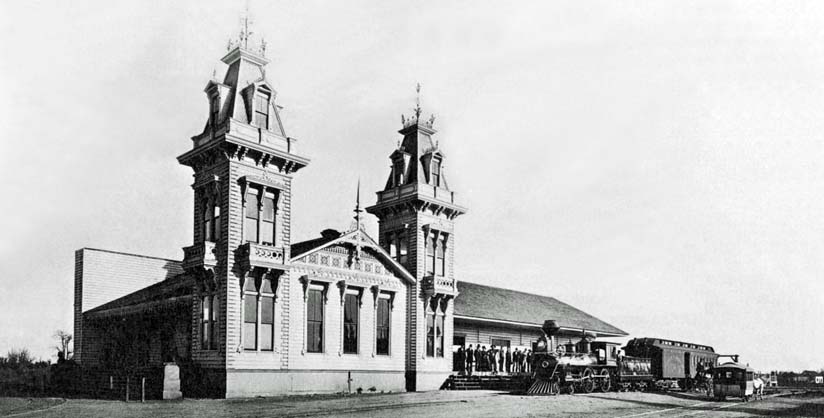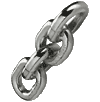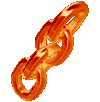
The tiny upstart Los Angeles & Independence Railroad, known as the LA&I, was embroiled in a complex and intense race in January 1875, with the mighty Southern Pacific Railroad (SP) to build the first railroad through the Cajon Pass.
The companies were competing for the right-of-way through the mountain pass, which would give the owner control of freight between Southern California and the mining regions of Inyo County.
Southern California experienced significant population growth in the early 1870s, and during this period, the long-term success of a city often depended on having a railroad connection.
In 1872, desperate and disgruntled Los Angeles County voters passed a bond totaling more than US$610,000 to subsidize Southern Pacific's construction costs to build a rail connection from the transcontinental line in Central California to Los Angeles.
With a transcontinental connection already in the works, Los Angeles businessmen were eager to build their own railroad to San Bernardino and the rich mining regions to the north.
In March 1874, a consortium of businessmen, mining moguls, and politicians, pushed a bill through the California Legislature that granted them a railroad right-of-way from Los Angeles to Independence, in the heart of the Inyo County mining district.
The LA&I hired respected railroad engineer James U. Crawford in May of that year, to survey the line, and manage its construction.
Crawford believed the best route for a railroad would go through the Cajon Pass, and he quickly set out to survey the line from Los Angeles to the Inyo mines.
Crawford provided regular reports during his survey, and the 26 May 1874 edition of the Los Angeles Herald, carried this account:
"I returned to San Bernardino last night, having spent the last week in the careful exploration of the different approaches to Cajon Summit. I was accompanied on most of my expeditions by Mr. Fear, who resides on the line of Brown's toll-road, near the top of the mountain, to whose kind assistance, thorough woodcraft, and sure-footed mule, I am mainly indebted for any topographical knowledge I may have obtained."
Crawford's report concluded, "Cajon Pass is practicable for a railroad which can be cheaply constructed and operated with vast advantage to Los Angeles and her back country."
Crawford's initial survey and cost calculations showed the funding from the Los Angeles businessmen would not be enough to complete the line.
This shortfall brought in wealthy U.S. Senator John P. Jones of Nevada, who owned extensive mining interests in Inyo County, and was also investing in the new seaside resort town of Santa Monica.
In the late 1800s, the railroads were famous for having politicians in their hip pockets, and the SP was known for political shenanigans.
Like many of its other ventures, the SP began turning the battle for the Cajon Pass into a complicated web of political and operational maneuvering.
The LA&I's robust actions and progress likely inspired the SP to influence Congressman Sherman O. Houghton to introduce a bill that would allow the SP to change the agreed upon route into Los Angeles, and instead, bypass the city with a route through the Cajon Pass.
Residents of Los Angeles County were enraged at this double-cross, and Congressman John K. Luttrelle introduced a competing bill that would prevent the railroad from building in the Cajon Pass.
While the politicians were doing their work, the SP was keenly aware of Crawford's survey work in the Cajon Pass.
In early 1875, the SP sent a survey party to the Cajon Pass to stake out a route and secure their own right-of-way.
Between 8 and 12 Jan 1875, Crawford out-maneuvered the SP survey team, and was able to set his stakes in the narrowest section of the Cajon Pass (today's Blue Cut), thus ensuring the best right-of-way for the LA&I.
Newspaper accounts of the event claimed Crawford set his stakes and beat the SP team by only 1 hour.
Unaccustomed to defeat by a smaller foe, the SP abandoned their ground efforts to build their line through the Cajon Pass.
However, the SP continued to obstruct operations on the LA&I by refusing to allow them to cross their tracks east of Los Angeles, and build eastward.
Crawford went to work in earnest in the Cajon Pass, and he ordered men and equipment to begin grading and start work on a tunnel in the West Cajon Valley.
Crawford's route basically followed today's railroad route through the lower pass, but it turned west around today's Highway 138, and followed the general course of the highway through the West Cajon Valley.
At the present day intersection of Highway 138 and Paramount Road, the route made a sharp curve toward the northern ridge line of the West Cajon Valley, and the site of a major tunnel that would pierce the ridge and enter the High Desert.
In March 1875, it was reported that Crawford had 200 men working in the Cajon Pass, and in May, a steam-powered drill had been ordered for the tunnel.
By June, the tunnel was at 120 feet, and grading work continued.
With grading work spread out across Southern California, the only operational track on the LA&I was a 16.7 mile section between Los Angeles and the Santa Monica Wharf.
Service on that line began on 17 Oct 1875.
In spite of significant successes, all construction on the LA&I, east of Los Angeles was discontinued by 1876, and Crawford's men were pulled out of the Cajon Pass.
Plans were made to try and raise additional funds to continue the LA&I, but economic pressure finally put a stop to the railroad.
The feasibility of the LA&I was almost completely crushed when the SP completed its line into Los Angeles in September 1876, and a new wagon road from Inyo County to Bakersfield was also completed.
Even though Crawford and his well-placed survey stakes had won the battle of the Cajon Pass, Jones knew the LA&I was not sustainable.
The final piece of irony for the LA&I came in May 1877, when all assets from the railroad were sold to the SP.
The Cajon Pass was finally conquered by the California Southern Railroad in 1885.
Mark Landis.
provisions in Section 29 of the Canadian
Copyright Modernization Act.











